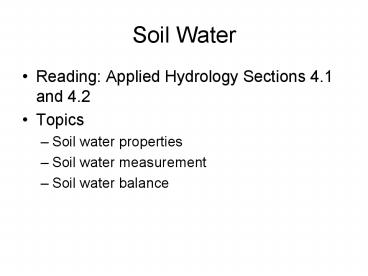Soil Water - PowerPoint PPT Presentation
1 / 26
Title:
Soil Water
Description:
Soil Water Reading: Applied Hydrology Sections 4.1 and 4.2 Topics Soil water properties Soil water measurement Soil water balance Subsurface water Infiltration Soil ... – PowerPoint PPT presentation
Number of Views:126
Avg rating:3.0/5.0
Title: Soil Water
1
Soil Water
- Reading Applied Hydrology Sections 4.1 and 4.2
- Topics
- Soil water properties
- Soil water measurement
- Soil water balance
2
Subsurface water
- Infiltration
- Soil moisture
- Subsurface flow
- Groundwater flow
3
Porous Medium Flow
- Groundwater
- All waters found beneath the ground surface
- Occupies pores (void space not occupied by solid
matter) - Porous media
- Numerous pores of small size
- Pores contain fluids (e.g., water and air)
- Pores act as conduits for flow of fluids
- The storage and flow through porous media is
affected by - Type of rocks in a formation
- Number, size, and arrangement of pores
- Pores are generally irregular in shape because of
- differences in the minerals making up the rocks
- geologic processes experienced by them.
4
Zones of Saturation
- Unsaturated zone
- Zone between the land surface and water table
- Pore contains water and air
- Also called as vadose zone or the zone of
aeration - Saturated zone
- pores are completely filled with water
- Contains water at greater than atmospheric
pressure - Also called phreatic zone
- Water table
- Surface where the pore water pressure is
atmospheric - Divide between saturated and unsaturated zone
- Capillary fringe
- Zone immediately above the water table that gets
saturated by capillary forces
5
Soil Water
Three categories
- Hygroscopic water
- Microscopic film of water surrounding soil
particles - Strong molecular attraction water cannot be
removed by natural forces - Adhesive forces (gt31 bars and up to 10,000 bars!)
- Capillary water
- Water held by cohesive forces between films of
hygroscopic water - Can be removed by air drying or plant absorption
- Plants extract capillary water until the soil
capillary force is equal to the extractive force - Wilting point soil capillary force gt plant
extractive force - Gravity water
- Water that moves through the soil by the force of
gravity
- Field capacity
- Amount of water held in the soil after excess
water has drained is called the field capacity of
the soil.
6
Soil Sieves
http//www.rtg.wa.edu.au/loanpool/belmont/sieves.j
pg
7
Soil Particle Sizes(USDA Soil Classification
System
Table 1. Size limits (diameter in millimeters) of
soil separates in the USDA soil textural
classification system.
1 mm
0.1 mm
0.01 mm
.
0.001 mm
8
http//www.uga.edu/srel/kidsdoscience/soils-planet
s/soil-particle-size.pdf
9
Soil Texture Triangle
Source USDA Soil Survey Manual Chapter 3
10
Soil Water Content
Soil Water Content
11
Soil Water Flux, q
q Q/A
12
Soil Water Tension, y
- Measures the suction head of the soil water
- Like p/g in fluid mechanics but its always a
suction (negative head) - Three key variables in soil water movement
- Flux, q
- Water content, q
- Tension, y
Total energy head h
z0
z1
q12
z2
13
Soil Water Measurement
- Neutron scattering (attenuation)
- Measures volumetric water content (?v)
- Attenuation of high-energy neutrons by hydrogen
nucleus - Advantages
- samples a relatively large soil sphere
- repeatedly sample same site and several depths
- accurate
- Disadvantages
- high cost instrument
- radioactive licensing and safety
- not reliable for shallow measurements near the
soil surface - Dielectric constant
- A soils dielectric constant is dependent on soil
moisture - Time domain reflectometry (TDR)
- Frequency domain reflectometry (FDR)
- Primarily used for research purposes at this time
14
Soil Water MeasurementNeutron Attenuation
Measures Soil Water Content, ?
15
Soil Water Measurement
- Tensiometers
- Measure soil water potential (tension)
- Practical operating range is about 0 to 0.75 bar
of tension (this can be a limitation on medium-
and fine-textured soils) - Electrical resistance blocks
- Measure soil water potential (tension)
- Tend to work better at higher tensions (lower
water contents) - Thermal dissipation blocks
- Measure soil water potential (tension)
- Require individual calibration
16
Tensiometer for Measuring Soil Water Potential, ?
Water Reservoir
Variable Tube Length (12 in- 48 in) Based on Root
Zone Depth
Porous Ceramic Tip
Vacuum Gauge (0-100 centibar)
17
Electrical Resistance Blocks Meters
18
Soil Water Tension, y
- Measures the suction head of the soil water
- Like p/g in fluid mechanics but its always a
suction (negative head) - Three key variables in soil water movement
- Flux, q
- Water content, q
- Tension, y
Total energy head h
z0
z1
q12
z2
19
(No Transcript)
20
(No Transcript)
21
Darcys Law
- K hydraulic conductivity
- q specific discharge
- V q/n average velocity through the area
22
Definitions
Element of soil, V (Saturated)
Pore with water
solid
Pore with air
Element of soil, V (Unsaturated)
23
Continuity Equation
z
dy
dx
dz
y
x
24
Continuity (Cont.)
Continuity Equation
25
Surface Tension
- Below surface, forces act equally in all
directions - At surface, some forces are missing, pulls
molecules down and exert tension on the surface - If interface is curved, higher pressure will
exist on concave side - Pressure increase is balanced by surface tension,
s - s 0.073 N/m (_at_ 20oC)
air
Interface
Net forceinward
water
No net force
26
Richards Equation
- Recall
- Darcys Law
- Total head
- So Darcy becomes
- Richards eqn is
Soil water diffusivity































